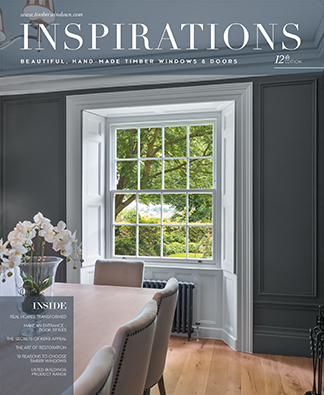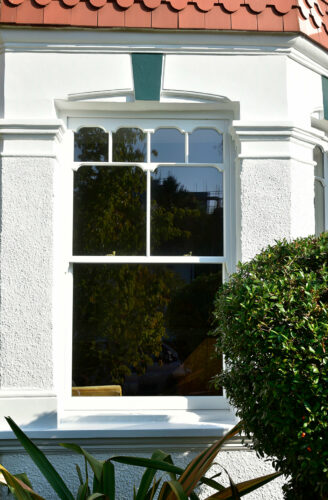The different eras of sash window
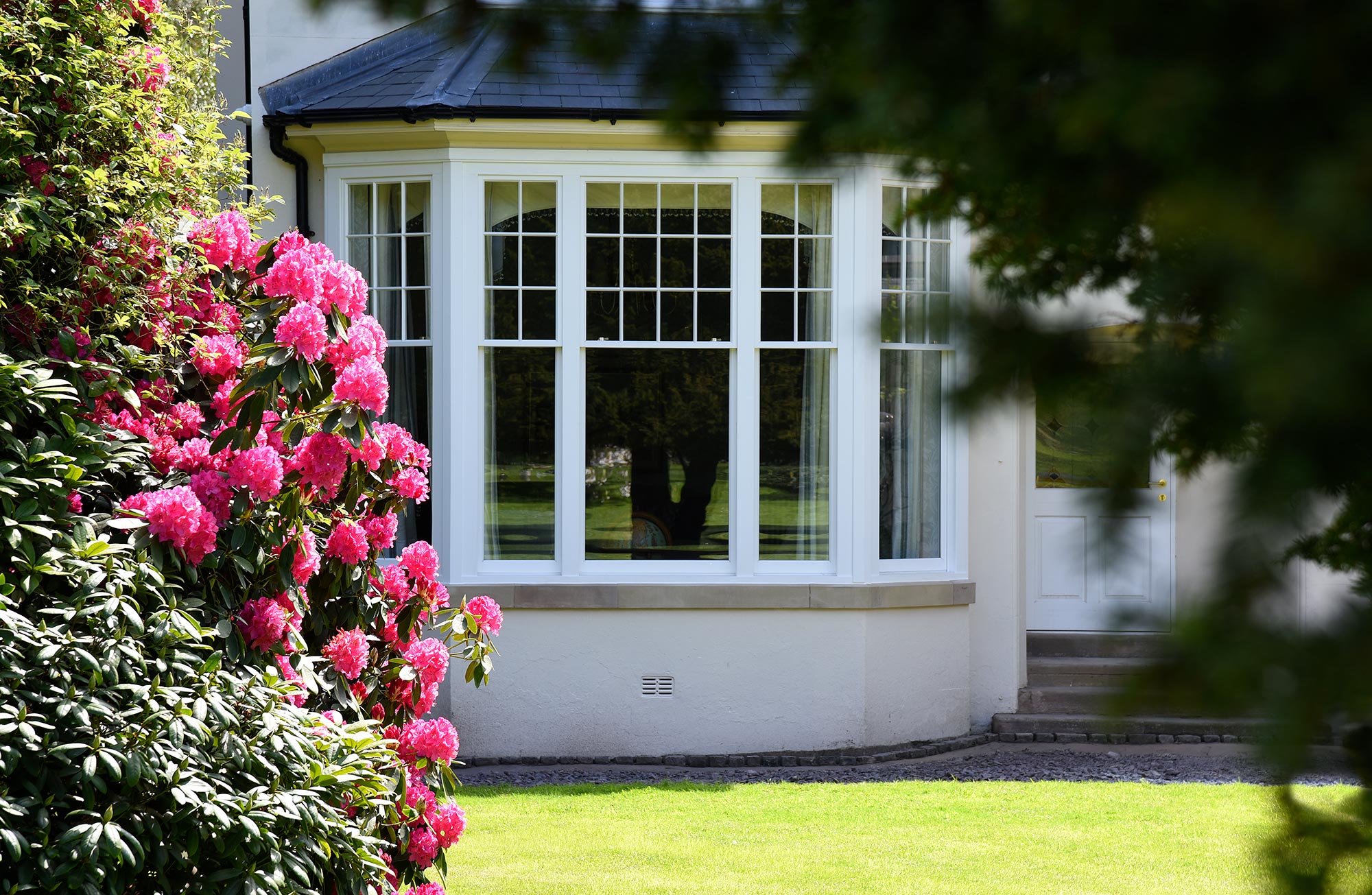
An icon of architectural design that spans multiple countries across numerous centuries and various architectural periods, a sash window is unmatched when it comes to truly beautiful windows. They slide elegantly using a weight and pulley mechanism and feature on some of the most beautiful buildings across the UK, and wider world. Towards the end of the 17th century, sash windows became more widely adopted in England, and their timeless appeal and prestige continues to show today.
Many original sash windows can still be found on historic buildings, and often, when renovating an older property, homeowners will have a desire to retain this original look, and ensure the character of the building is preserved, by specifying timber sash windows. While it would be ideal to keep the original windows, the time will come that the original is either beyond repair, or simply does not perform to a high enough standard anymore.
With sash windows being such a popular style of window for so many years, today we will delve into the 3 historical eras that have influenced their design in England. Regardless of the style, an authentic, timber sash window bring elegance, class, beauty and ultimately, value to the property it is installed in, and while timber alternative sash windows are an option, nothing can match real timber, and in some cases (such as Listed Buildings and Conservation Areas), are the sole material of choice.
If you own a home from such a period and are thinking of replacing your sash windows, this can serve as a handy guide, to ensure you select the style that is most in keeping for your property, and will retain its beauty and character for the years to come.
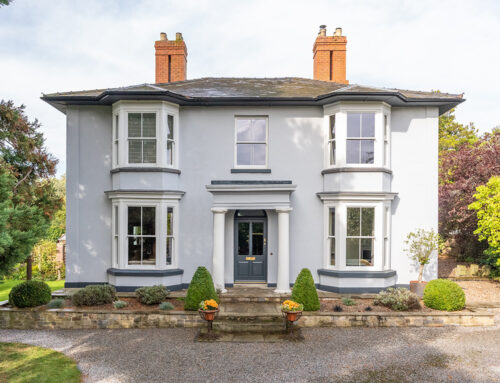
Georgian Sash Windows
The Georgian era in the UK began with the ascension of monarch, George I in 1714, lasting until the death of William IV in 1837. Among numerous reasons, the era has become synonymous with the arts. This period saw the published works of renowned authors & poets, Jane Austen, Daniel Defoe and William Blake (to name a few); while in different disciplines, famous painters and artists such as Thomas Gainsborough, John Constable and JMW Turner created their masterpieces. From a musical outlook, the Georgian era saw the rise of Mozart, Beethoven and Bach; names that even today, are synonymous with being at the very top of craft and expertise, taught at music institutions worldwide.
The period, from an architectural perspective, is still prevalent today, especially in the historic cities of Bath, Bristol and London to name a few of many examples. Advances in glass-making techniques and processes during this period allowed sash windows to become more widely adopted across the country, with almost all, including smaller, modest buildings, featuring sash windows.
With Georgian sash windows, their key identifying features are glazing bars in a square formation on both the upper and lower sashes, usually 6 over 2 or 8 over 2 (including the example below). This symmetrical, timeless style is still a popular specification today, especially with farmhouses, townhouses and grand stone properties. They allow for homes to have a balanced look that suits multiple property styles and ages.
The Georgian style of window is also popular with casement windows, with the square style of glazing bar design a widespread feature among both older properties, and new build properties (for developers wishing to add some character and style to the new dwellings).
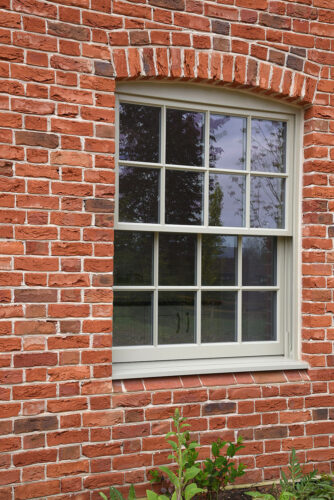
Victorian Sash Windows
The death of monarch, William IV, saw the end of the Georgian era, and the beginning of the Victorian, with the ascension of his niece, Queen Victoria, who reigned from 1837 to 1901. The aptly named Victorian era covered her reign and until the reign of Elizabeth II, Victoria was our longest serving monarch. The era saw the country take a great number of steps forward societally, with advances in universal education, technological developments and the passing of the 3 Reform Acts, which changed electoral votes in the country greatly, taking great steps towards the country becoming a democracy.
Sash windows during this era changed as new styles were introduced due to advances in window technology and manufacturing processes. While Georgian sash windows feature a symmetrical glazing bar pattern, Victorian sash windows are known for having either a singular, vertical glazing bar, or no bars at all. These designs allowed for a greater level of natural light to flow into homes. Where glass making technologies allowed for larger, singular panes of glass to be manufactured and applied into windows, the strength of the frame was able to take this greater glass weight.
This change in style between eras was not just with the glazing bar design however. Victorian era sash windows also introduced sash horns, which provided additional support and strength to the frame of the window, while adding character and beauty.
Design was a key feature of Victorian era architecture. Advances in technology and manufacturing allowed more intricate, bespoke mouldings and works to be crafted. Bay windows especially were on the rise, while many were set within intricate stone mullions featuring beautiful, unique designs, which are still prevalent today among numerous townhouses and grand properties across the country and cities. Stained glass also became more commonly adopted among the richer parts of society due to advances in glass making and design, which has only increased greater today as it has become more available for wider society.
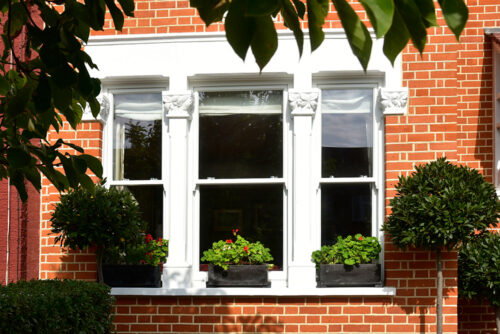
Edwardian Sash Windows
The shortest of the 3 periods we are covering today, the Edwardian period in England lasted only from 1901 (from the death of Victoria) to 1910 following the death of Edward VII. Some historians and sources differ on this however, with some citing the end of the era in 1920 to include the First World War. This period also saw the rise of the women’s suffrage movement, before their successes in parliament in 1918 and later in 1928. While a short spanning era, it saw rapid changes throughout society, particularly in the fashion, industrial and architectural sectors.
Architecturally, the Edwardian Era is heavily associated with the Arts & Crafts movement. More buildings were constructed using red brick during this time, and featured more windows than ever before (the ending of the Window Tax in 1851 also helped contribute to this). Edwardian sash windows can almost be seen as a combination of the Georgian and Victorian eras in a way. Partly this is due to the improvements in technology and manufacturing during the era, allowing previous designs to be more easily combined and created, while also reflecting the changes in tastes and desires of homeowners and architects over time.
Often with an Edwardian sash window, you will find the upper sash has Georgian style glazing bars (or more bespoke, Tombstone style designs; see image below as a reference), and a fully glazed, or singular glazing bar on the lower sash. This combination of styles allows plenty of light to flow into the home, while creating more design combinations and possibilities, which makes them more applicable in a greater number of property styles.
Another feature of an Edwardian sash window is that it is not uncommon to see the two sashes (upper and lower) at uneven sizes. The upper sash will usually be more decorative, featuring more glazing bars in a variety of styles, and as such, is usually smaller than the lower, opening sash. This is also the same for Edwardian casement windows; a feature in numerous cities, particularly Birmingham for example where the mid rail of the window is higher, creating smaller, top fanlights.
Modern Day Timber Sash Windows
Nothing can match the beauty and kerb appeal of a real timber sash window. They have transcended centuries and eras, to still be one of the most popular and desirable window styles in today’s world. Through looking at the different eras, you can see how designs have adapted over the years as tastes have changed and manufacturing capabilities have increased.
The result being that today, you have more choice than ever before when it comes to new sash windows. Eras are more blended together now, and you can often find a traditionally styled Georgian sash window, with Victorian style sash horns for example. An increasing number of homeowners are wanting to take their property back to its roots, and put sash windows back in, where a previous owner had replaced them with ill-suiting, alternative windows, that meant the property did not look as originally intended. This helps restore a property’s beauty, pay respect to its history and architecture, while adding value at the same time.
While timber alternative materials have become more available to homeowners, a timber alternative sash window cannot compete with the beauty of real timber sash windows. For homes in Conservation areas or protected with a Listed status, timber is often the only viable material as well. Our timber sash windows are manufactured from engineered timber, which is a strong, long-lasting material that does not twist, warp, or get stuck over time, that sash windows from years past were prone to as the wood aged.
Our range is also highly customisable, allowing you to create and design the perfect sash windows for your home, whether that be Georgian, Victorian or Edwardian. We will delve further into how our sash windows can be adapted and customised in a future post. If you would like to explore our range more in the meantime, you can do so here, or to see and try one for yourself, please do visit your local showroom, where examples from our beautiful range are on display in a warm and welcoming environment.


